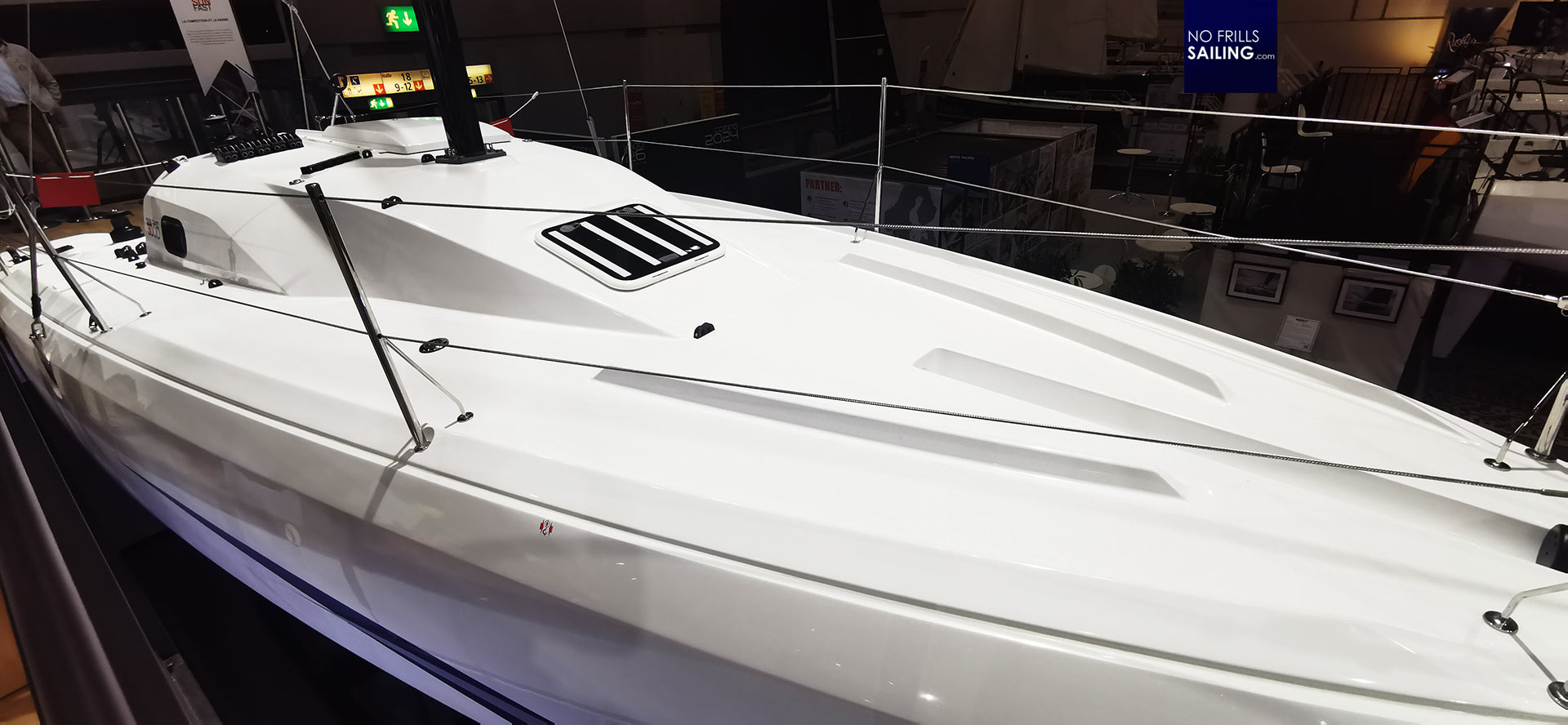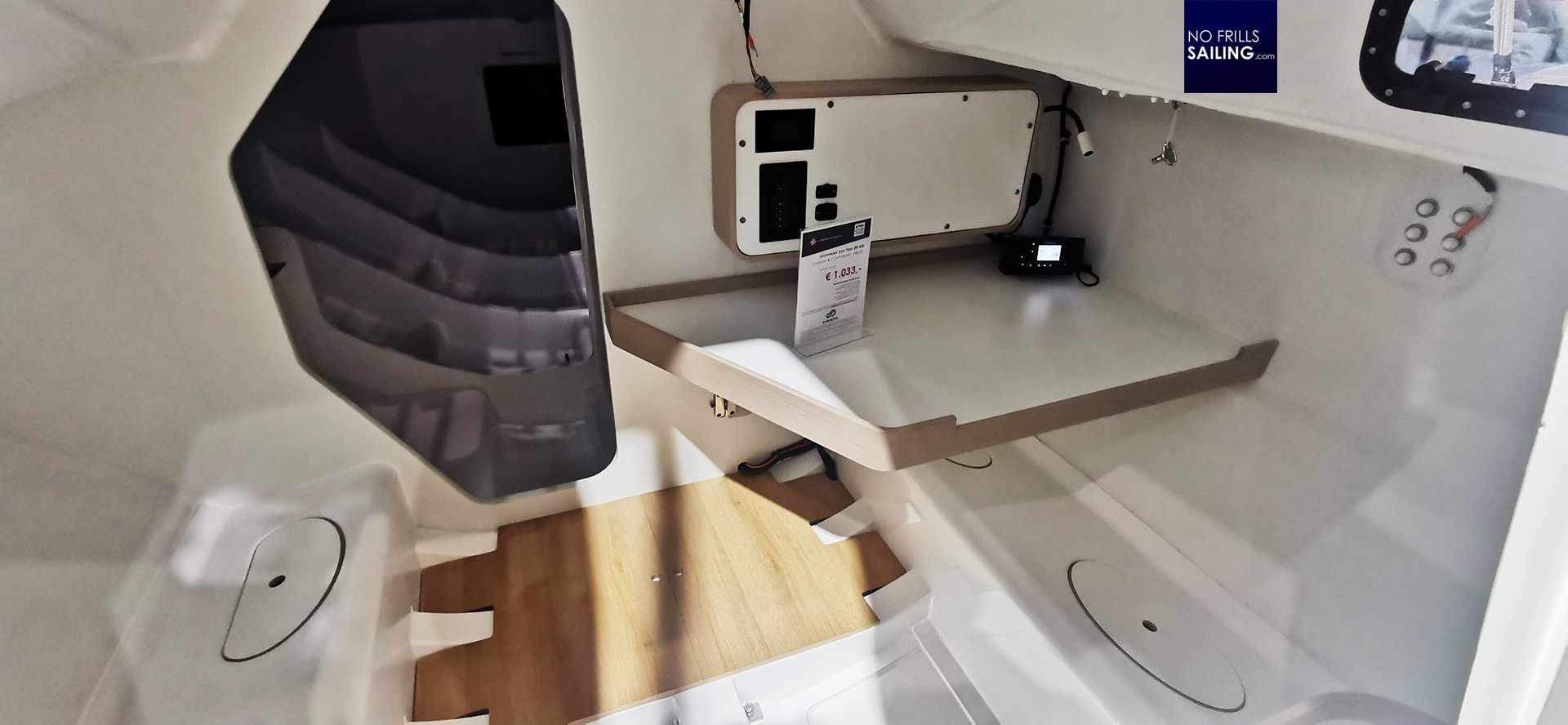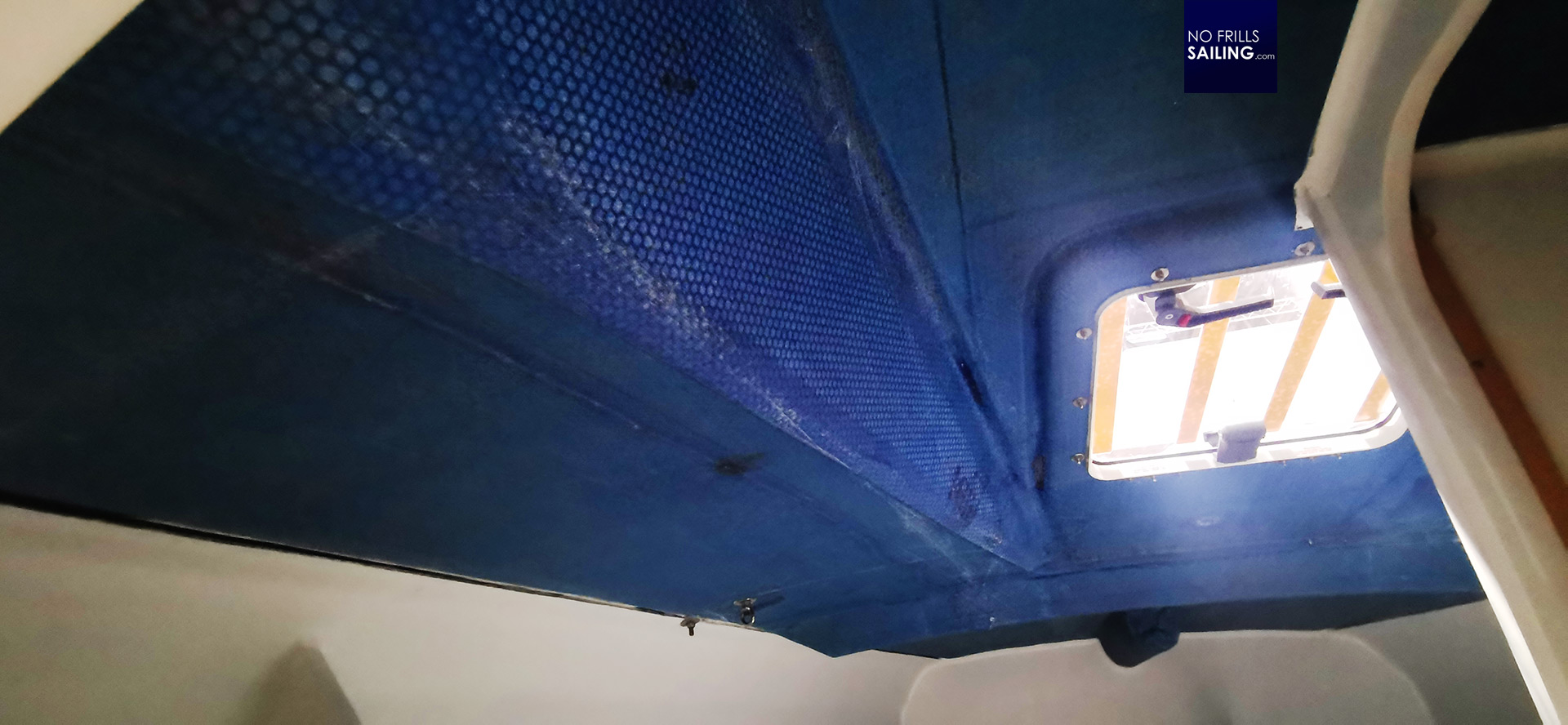The second boat of the Boot Duesseldorf 2024 walkthrough-series shall as well be a Jeanneau. After a bit humorous opening with the Jeanneau Yachts 55 a few days ago, let´s check out a boat that sits on the exact antipode of sailing compared to the big flagship: The all-new SunFast 30 OD had her world premiere at Duesseldorf and seeing her was definitely among the top boats I´d liked to visit. On a quiet Sunday morning, still 1.5 hours to the opening bell of the show, I went over to the Jeanneau booth. Vacuum cleaners humming all along, the guys being busy to bring the stand to high gloss presentation mode.

There has been a lot of fuzz around this new racing boat. The 30 feet racing boat class seems like the “seet spot” for boat builders to attract newcomers, about-to-be-pros and amateur racers alike. There is of course a very colorful palette of attractive boats, just like the Cape 31, Farr/Mumm 30, Figaro 3 or Dehler 30 OD, to name just a few. This class is particularly interesting as those boats are easily trailerable, affordable budget-wise and offshore-rated. The boom of single- and double-handed races in Europe and abroad did the rest, not to mention the still undecided future new Olympic class. So, let´s see what Jeanneau came up with …
Initial mixed feelings
The new SunFast 30 OD had been presented in a dedicated corner of the sailboat stand, a bit off from the big Sun Odyssey units. I would have rejoiced if Jeanneau had done a bit more effort in her presentation, she seemed a bit understated, her presence a bit boring. Anyway, there she was. Measurements are quite easy on that one: 10.40 m LOA with a waterline length of 8.40 metres. Her width is 2.99 metres maimum, which is the first surprise: Figaro 3 has 3.48 metres, Dehler 30 OD has 3.25 metres. Her cockpit and layout is something new.

The Jeanneau SunFast 30 OD sports just three winches. That´s one working winch for halyards, reefing and trimming lines on the coachroof right next to the entryway down below. Two Genoa winches on the low coamings. The mainsheet will be trimmed by hand, just like I had it on the First 27 SE, all principle trimming lines except for the Genoa/Jib-sheets are diverted to the one working winch. I found this highly unusual since, for example in reefing, I´d like to have have two winches from which I can operate the main halyard and the reefing line at the same time.

The entryway down to the cabin is offset from the middle axis to portside. This makes it possible to dedicate almost half of the entire area on the roof to the lines and main winch. Underneath a small 7 inch chart plotter and auto pilot panel are located. Some more jammers (three + one to either side) are on the coamings leading to rope-bags but since they had not been installed it´s hard to identify their purpose.

As I stated, I find this three-winch-layout interesting, yet it remains to be checked when the boat is fully rigged. In single handed mode this is no problem I guess – excluded the reefing action as mentioned above – and it certainly saves some budget on one winch, but I don´t know if I like it. Also in terms of redundancy: If something breaks or jams underway, there´s no way to switch to a fallback winch. A nice big mainsheet traveler at the stern end, something familiar, and frame hoops to wedge oneself into when sailing. “Mixed feeling” I said about it … to be honest, I find the First 27 SE-cockpit ergonomically and from the possibilities of trimming superior. Just three winches …
A new One Design Class
Speaking with some friends and befriended skippers on the show about this boat, their feedback is equally mixed. “It looks like a small SunFast 3300”, one of them said. Well, it´s obvious that it does so: Clearly Jeanneau had to come up with a boat that is true to the SunFast DNA and blends in with her predecessors. The – in the end far less excessively pronounced – scow bow and her hull design apparently made for planning on reaching and downwind courses make her unmistakably a SunFast and I am sure her fans will like it. Another guy I spoke about told me that he will sail “circles around her on any point of sail and in any weather and wind conditions.”

That said, I think that comparing the 30-footer racing boats to each other is just an academic thought experiment. It has no real value since the intended use of those boats, as imperative with the name “one design”, is to race each other in a closed class. No matter if the Dehler 30 OD is the better overall performer (which I think is true) or the Figaro 3 is the faster boat on certain courses, the true big hurdle to master and the one big challenge for the SunFast 30 OD is the “OD” – is the boat Jeanneau is offering attractive enough for a class to form?

Speaking of Dehler and Figaro, these are two examples of just how hard this is. The Figaro class had been founded back in 1990 and is since then the – at least on the European continent and for sure in France – established in the offshore racing circus. The advent of the Figaro 3 caused a kind of stirrup (foils, budgets and so on) and it took some time for the boat to be accepted. The Dehler 30 OD however adds boat by boat to the class but it will take many years to form something as big as the Figaro. So, looking at the SunFast – a French boat too – how will they manage to set up a totally new class, a racing calender that is attractive and demanding? Far more exciting, if you ask me, than looking at the boat itself.
All out racing
I liked the simple and efficient way they retract the bowsprit into the boat. No fixed bowsprit which is prone to damage both in harbor and whilst transporting but no folding mechanism either. Also, as on the First 27 SE/Seascape 27, the retraction mechanism needs not to be inside the boat, so no intrusion of water leakage as well. A nice detail. Let´s go down and check her interiors.

I was a bit shocked, I must admit. Of course, this is an all-out racer and terms like “comfort” or “coziness” had clearly been missing in the design brief. This is a sports utility built with maximum efficiency, weight saving and structural integrity. It is surely not a boat to attract or instill any form of cruising comfort. The salon is small and vis-à-vis the entryway there´s the main bulkhead, taking on the forces of the deck-stepped mast. To starboard side a little nav station with a desk, main switch panel and VHF is located.

Side benches with stowage (no cushions) to either side. Looking back, two pilot berths in the aft section of the boat are behind a second major frame. Right of the entryway´s ladder a sink with a small fresh water canister is located – a bit awkward since the head is in front of the main bulkhead. Anyway, maybe a small galley cooker can be set up here so that the sink makes some sense then.

Everything down below here is very, very simple, very basic. Light weight was of utmost importance and clearly Jeanneau hasn´t wasted any of its budget for bric-a-brac or decorative elements. I am sure, skippers aboard will be fast decorating this pure white interior by Edding, stickers or else – I did not really like the atmosphere, I shall say. Mixed feelings, here they are again.
Who will buy the SunFast 30 OD?
I crawl forward to take a look kinto the head. A simple room, no door, just a Jabsco pumping WC on a small pedestal. In my head I try to imagine a sailor aboard this boat, auto pilot engaged, waves hammering the hull, the storm hollers through the rigging. Spray is coming down the entryway, it´s wet and cold … is this a boat conveying trust, stability and a feeling of security? For me, just for me personally, the SunFast 30 OD is a bit too cold. I am missing a kind of soul here …

So who is buying such a boat? The boat will start at around 140.000 Euros base price ex VAT and will clock in at around 200.000 Euros plus sails plus VAT. That´s around the same price tag as the Dehler 30 OD, but much less than a Figaro 3 is costing. In any case, a future buyer of the SunFast 30 OD should ask himself exactly the same questions I´ve formulated above: What will the class have to offer for me as an owner to sail this boat in attractive races against as many of the same boats? Because, if Jeanneau fails to set up a decently sized class and a competitive racing events calender, the Dehler 30 OD in my view is the superior boat as she offers some decent cruising qualities on top.

Also, the Figaro 3 or Farr X2 – in my opinion – deliver my power and sailing performance than the SunFast 30 OD and I´d choose them if I was looking for an all-out regatta boat. So I guess that will be the one big question to be answered, determining either a bright future for the the SunFast or an existence as a niche boat for her: Will there be an attractive class drawing in some young ambitious sailing talents?
Innovations
Anyway, the SunFast 30 OD marks another zero point for the industry. Groupe Beneteau, in their struggle to become more sustainable, launched in her the first series production boat made with recyclable resin. Arkema´s “Elium” resin has been thoroughly tested in the past years in various prototypes (I wrote about the First 44 testbed almost one year ago) and in the labs, now, with the SunFast 30 OD, this technology is available for anybody.

It´s not just a special option and mark you set on your options list: The SunFast 30 OD is only available in Elium-resin. It makes sense to launch this full scale a bit “scaled down” in a racing boat class. First, these boats are relatively small and even if the new class is a boomer, the units built will be in their dozens, maybe 100 or 150, but not hundreds. In this, Jeanneau creates a client base of beta testers that is manageable and relatively small-sized. Secondly, it´s a race boat …

This means that each boat will be sailed comparatively hard in terms of mechanical and structural stresses. Thus, one SunFast will experience far more stress than an kempt owner´s cruising boat. If things happen, they will happen more quickly and decisively on a racing boat. Prompt feedback won by each SunFast-skipper for the shipyard. A clever move.

I enter the bow section of the boat forward of the main frame. The hull is painted in white, the deck section left unpainted. A pale dark blue color welcomes me, clearly, Jeanneau did no efforts in making the B-side of the vacuum infused deck look a bit more pretty. The dark tone of the roof intensifies the kind of depressing feeling, dark, squat. As a skipper, this would surely be my first and foremost task: Making this a happy boat.

A rectangular hatch opens up to the crash box in the very bow of the boat. Although being very small, the scow bowed-hull creates a huge volume. An effect I have been very impressed by aboard the Vector 4 Mini 6.50 I visited and sailed on last summer. Surely, a skipper will be able to store his sails, spare parts and many provisions aboard a SunFast 30 OD – maybe a nice project would be a Transat race?
Let´s see how she will perform
I am sure the new SunFast 30 OD is an agile little boat with a lot of potential to create sailing fun and high speed craze. The offer by Jeanneau to enter offshore single and double handed racing with a boat starting at this price seems valid and attracted, yet it remains open if a class can form that by itself can draw in new skippers. I am excited to see the SunFast 30 OD in the coming years and maybe one will be sailing nearby.

I am and I will be a Figaro-guy, never really got warm with the SunFasts. Nevertheless, checking what Vincent Lauriot Prevost, father of both Figaro 3 and SunFast 30 OD promised, I think she will find her buyers and ambitioned sailors. One thing is for sure, a headline worth a lot in these days: First boat fully recyclable. A step forward in the right direction!
You may also like to read these connected articles:
Talking the new SunFast 30 OD concept
First SunFast 30 OD hits the water
At the Figaro 3 production in Nantes
